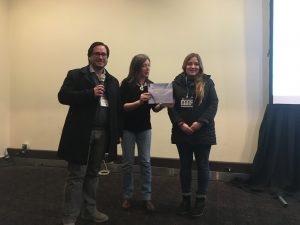En el marco de la XL Reunión Anual de la Sociedad de Bioquímica y Biología Molecular de Chile, efectuada entre los días 26 y 29 de septiembre de 2017 en la ciudad de Puerto varas, la alumna de la Facultad, Michelle Salazar, obtuvo el “Premio Fermelo-Sociedad de Bioquímica (SBBMCH).
Este se otorga a la mejor comunicación libre oral, la mejor comunicación libre panel y el mejor trabajo de incorporación y son entregados a expositores del congreso de la SBBMCh. Tienen como objetivo dar un apoyo a investigadores por méritos en sus trabajos y que hayan realizado una excelente exposición, con la condición que los dineros entregados sean destinados a asistir a otros congresos o eventos científicos.
La tutora del trabajo fue la investigadora María Inés Becker.
Michelle tuvo la gentileza de responder nuestras preguntas respecto a este premio:
-¿Cuál es el nombre de la presentación y cuál es su objetivo?
–“El trabajo que presenté se titula “Effect of enzymatic elimination of N-glycosylations on the structure and immunogenic properties of mollusk hemocyanins”, y se enmarca en mi tesis de Magíster, la cual realizo en FUCITED, con el apoyo de Biosonda S.A, bajo la dirección de la Dra. María Inés Becker.
–¿Cómo te sientes al recibir esta distinción?
–“Es un gran honor y fue algo totalmente inesperado, pues había muchísimos trabajos de gran nivel. En conjunto con el laboratorio tratamos de presentar un trabajo completo, que mostrara varios de los resultados que tenemos, pero que al mismo tiempo fuese auto-explicativo y fácil de comprender. Ese mismo principio intenté aplicarlo en la exposición oral de nuestro trabajo, nos preocupamos de que fuera una presentación ordenada, que tuviera énfasis en los resultados pero sin dejar de lado el contexto de nuestra investigación. Al parecer estas consideraciones, además del trabajo que realizamos en el laboratorio, nos permitieron obtener esta distinción que personalmente, me produce gran entusiasmo pues, es un incentivo para seguir creciendo y mejorando como estudiante y futura profesional científica.
¡Felicitaciones a Michelle por este logro!!!
En la fotografía, le entrega el reconocimiento la profesora Lorena García.


